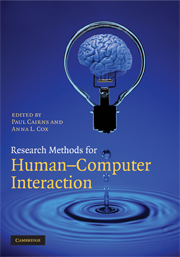Book contents
- Frontmatter
- Contents
- List of figures
- List of tables
- List of contributors
- Preface
- 1 Controlled experiments
- 2 Questionnaires, in-depth interviews and focus groups
- 3 Eyetracking in HCI
- 4 Cognitive modelling in HCI research
- 5 Formal analysis of interactive systems: opportunities and weaknesses
- 6 Using statistics in usability research
- 7 A qualitative approach to HCI research
- 8 Methodological development
- 9 Theoretical analysis and theory creation
- 10 Write now!
- 11 Applying old research methods to new problems
- References
- Index
Preface
Published online by Cambridge University Press: 05 April 2016
- Frontmatter
- Contents
- List of figures
- List of tables
- List of contributors
- Preface
- 1 Controlled experiments
- 2 Questionnaires, in-depth interviews and focus groups
- 3 Eyetracking in HCI
- 4 Cognitive modelling in HCI research
- 5 Formal analysis of interactive systems: opportunities and weaknesses
- 6 Using statistics in usability research
- 7 A qualitative approach to HCI research
- 8 Methodological development
- 9 Theoretical analysis and theory creation
- 10 Write now!
- 11 Applying old research methods to new problems
- References
- Index
Summary
Why write this book?
Human–Computer Interaction (HCI) is a clearly multidisciplinary subject. It has historically grown out of both computer science and psychology but in addressing the full complexity of how people use computers it has also grown to encompass social sciences, organisational theories, cognitive ergonomics and even philosophy. These areas all have their own traditions for how to make a useful contribution to knowledge. This means that researchers coming into HCI, be they MSc students, PhD students or even established academics from another area, are rarely aware of the full range of methods that can be used to provide a useful contribution to HCI knowledge. Moreover, it is through awareness of the range of research methods that good researchers realise that a narrow approach to HCI may not be most appropriate in providing a substantial contribution to the area.
The purpose of this book is to describe and demonstrate research methods used in HCI so that new researchers in this area are aware of the possible sorts of research that can be done. In addition, through demonstrating how such research has been done, the book will provide a starting reference for a researcher who is intending to use a particular method. This book will not therefore tell you everything you need to know about a particular method, but it will tell you where you can find out more.
- Type
- Chapter
- Information
- Research Methods for Human-Computer Interaction , pp. xiii - xviPublisher: Cambridge University PressPrint publication year: 2008

